EEG Data Augmentation Method Based on the Gaussian Mixture Model
Abstract
1. Introduction
2. Materials and Methods
2.1. The BCI Competition IV Dataset 2a
2.2. Gaussian Mixture Model
2.3. Gaussian Mixture Model-Based EEG Feature
2.4. Gaussian Mixture Model-Based EEG Data Augmentation Method
| Algorithm 1: EEG Data Augmentation Method Based on Gaussian Mixture Model |
| Input: original_data = (trial, channel, n_samples), original_labels = (trial,) |
| Output: gmm_data |
| Step1: Set model parameters. n_components = 10; random_stata = 42; = 0.8 |
| Step2: With the same label data, calculate the GGM features |
| probs = gmm.predict_proba (original_data) |
| means = gmm.means_ |
| covariances = gmm. covariances_ |
| weights = gmm.weights_robs |
| Step3: Sampling. |
| for do |
| for do |
| for do |
| end |
| end |
| end |
| Step4: Calculate the product matrix. |
| weighted_probs_values = gmm.weights_ * probs |
| Step5: Swap similar points. |
| weighted_probs_values = swap_columns (weighted_probs_values, ) |
| Step6: Fit the data. |
| data_generate_sampel = np.matmul (weighted_probs_values, fitted_values) |
| Step7: Swap channels and reconstruct the data. |
| gmm_data = GMM_FEATURE (probability = probability, random_state=42) |
2.4.1. Decomposition
2.4.2. Reconstruction
2.5. Evaluation and Criteria
2.5.1. Pearson Correlation Coefficient
2.5.2. Classification Accuracy
3. Experiment and Results
3.1. Data Preprocessing
3.2. Comparison of Data Characteristics Generated by Different Augmentation Methods
3.2.1. Waveform Comparison
3.2.2. Topographic Brain Map Comparison
3.3. Comparison of the Effectiveness of Data Generated by Different Augmentation Methods on Classification Models
3.3.1. Dataset Partitioning and Model Parameters
3.3.2. Classification Result
3.3.3. ROC Curve Comparison
3.4. Comparison of Visualization Results Between Original Data and the Data Augmented Using the Gaussian Mixture Model (GMM)
4. Discussion
5. Conclusions
Author Contributions
Funding
Data Availability Statement
Conflicts of Interest
Abbreviations
| EEG | Electroencephalogram |
| GANs | Generative Adversarial Networks |
| VAEs | Variational Autoencoders |
| SNR | Signal-to-noise Ratio |
| GMM | Gaussian Mixture Model |
References
- Abdul Hussain, A.; Singh, A.; Guesgen, H.; Lal, S. A Comprehensive Review on Critical Issues and Possible Solutions of Motor Imagery Based Electroencephalography Brain-Computer Interface. Sensors 2021, 21, 2173. [Google Scholar] [CrossRef] [PubMed]
- Roy, Y.; Banville, H.; Albuquerque, I.; Gramfort, A.; Falk, T.H.; Faubert, J. Deep learning-based electroencephalography analysis: A systematic review. J. Neural Eng. 2019, 16, 051001. [Google Scholar] [CrossRef]
- Craik, A.; He, Y.; Contreras-Vidal, J.L. Deep learning for electroencephalogram (EEG) classification tasks: A review. J. Neural Eng. 2019, 16, 031001. [Google Scholar] [CrossRef]
- Luo, Y.; Lu, B.L. EEG Data Augmentation for Emotion Recognition Using a Conditional Wasserstein GAN. In Proceedings of the 2018 40th Annual International Conference of the IEEE Engineering in Medicine and Biology Society (EMBC), Honolulu, HI, USA, 17–21 July 2018; pp. 2535–2538. [Google Scholar] [CrossRef]
- Sakai, A.; Minoda, Y.; Morikawa, K. Data augmentation methods for machine-learning-based classification of bio-signals. In Proceedings of the 2017 10th Biomedical Engineering International Conference (BMEiCON), Hokkaido, Japan, 31 August–2 September 2017; pp. 1–4. [Google Scholar] [CrossRef]
- Krell, M.M.; Kim, S.K. Rotational data augmentation for electroencephalographic data. In Proceedings of the 2017 39th Annual International Conference of the IEEE Engineering in Medicine and Biology Society (EMBC), Jeju Island, Republic of Korea, 11–15 July 2017; pp. 471–474. [Google Scholar] [CrossRef]
- Lashgari, E.; Liang, D.; Maoz, U. Data augmentation for deep-learning-based electroencephalography. J. Neurosci. Methods 2020, 346, 108885. [Google Scholar] [CrossRef] [PubMed]
- Um, T.T.; Pfister, F.M.J.; Pichler, D.; Endo, S.; Lang, M.; Hirche, S.; Fietzek, U.; Kulić, D. Data augmentation of wearable sensor data for parkinson’s disease monitoring using convolutional neural networks. In Proceedings of the 19th ACM International Conference on Multimodal Interaction, New York, NY, USA, 6–9 June 2017; ICMI ’17. pp. 216–220. [Google Scholar] [CrossRef]
- Lotte, F. Signal Processing Approaches to Minimize or Suppress Calibration Time in Oscillatory Activity-Based Brain–Computer Interfaces. Proc. IEEE 2015, 103, 871–890. [Google Scholar] [CrossRef]
- Pei, Y.; Luo, Z.; Yan, Y.; Yan, H.; Jiang, J.; Li, W.; Xie, L.; Yin, E. Data Augmentation: Using Channel-Level Recombination to Improve Classification Performance for Motor Imagery EEG. Proc. IEEE 2021, 15, 645–952. [Google Scholar] [CrossRef]
- Kim, S.J.; Lee, D.H.; Choi, Y.W. CropCat: Data Augmentation for Smoothing the Feature Distribution of EEG Signals. In Proceedings of the 2023 11th International Winter Conference on Brain-Computer Interface (BCI), Gangwon, Republic of Korea, 20–22 February 2023; pp. 1–4. [Google Scholar] [CrossRef]
- Luo, Y.; Zhu, L.Z.; Wan, Z.Y.; Lu, B.L. Data augmentation for enhancing EEG-based emotion recognition with deep generative models. J. Neural Eng. 2020, 17, 056021. [Google Scholar] [CrossRef] [PubMed]
- Schwabedal, J.T.C.; Snyder, J.C.; Cakmak, A.; Nemati, S.; Clifford, G.D. Addressing Class Imbalance in Classification Problems of Noisy Signals by using Fourier Transform Surrogates. arXiv 2018. [Google Scholar] [CrossRef]
- Rommel, C.; Moreau, T.; Gramfort, A. CADDA: Class-wise Automatic Differentiable Data Augmentation for EEG Signals. arXiv 2021, arXiv:2106.13695. [Google Scholar]
- Deiss, O.; Biswal, S.; Jing, J.; Sun, H.; Westover, M.B.; Sun, J. HAMLET: Interpretable Human And Machine co-LEarning Technique. arXiv 2018. [Google Scholar] [CrossRef]
- Saeed, A.; Grangier, D.; Pietquin, O.; Zeghidour, N. Learning From Heterogeneous Eeg Signals with Differentiable Channel Reordering. In Proceedings of the ICASSP 2021-2021 IEEE International Conference on Acoustics, Speech and Signal Processing (ICASSP), Toronto, ON, Canada, 6–11 June 2021; pp. 1255–1259. [Google Scholar] [CrossRef]
- Chawla, N.V.; Bowyer, K.W.; Hall, L.O.; Kegelmeyer, W.P. SMOTE: Synthetic minority over-sampling technique. J. Artif. Int. Res. 2002, 16, 321–357. [Google Scholar] [CrossRef]
- Wang, F.; Zhong, S.H.; Peng, J.; Jiang, J.; Liu, Y. Data Augmentation for EEG-Based Emotion Recognition with Deep Convolutional Neural Networks. In Proceedings of the MultiMedia Modeling, Bangkok, Thailand, 5–7 February 2018; pp. 82–93. [Google Scholar] [CrossRef]
- Mohsenvand, M.N.; Izadi, M.R.; Maes, P. Contrastive Representation Learning for Electroencephalogram Classification. In Proceedings of the Machine Learning for Health NeurIPS Workshop, Virtual, 11 December 2020; Alsentzer, E., McDermott, M.B.A., Falck, F., Sarkar, S.K., Roy, S., Hyland, S.L., Eds.; PMLR. Volume 136, pp. 238–253. [Google Scholar]
- Li, Y.; Huang, J.; Zhou, H.; Zhong, N. Human Emotion Recognition with Electroencephalographic Multidimensional Features by Hybrid Deep Neural Networks. Appl. Sci. 2017, 7, 1060. [Google Scholar] [CrossRef]
- Fu, R.; Wang, Y.; Jia, C. A new data augmentation method for EEG features based on the hybrid model of broad-deep networks. Expert Syst. Appl. 2022, 202, 117386. [Google Scholar] [CrossRef]
- Arjovsky, M.; Chintala, S.; Bottou, L. Wasserstein generative adversarial networks. In Proceedings of the 34th International Conference on Machine Learning-Volume 70, Sydney, Australia, 6–11 August 2017; ICML’17. pp. 214–223. [Google Scholar]
- Gulrajani, I.; Ahmed, F.; Arjovsky, M.; Dumoulin, V.; Courville, A. Improved training of wasserstein GANs. In Proceedings of the 31st International Conference on Neural Information Processing Systems, Red Hook, NY, USA, 4–9 December 2017; NIPS’17. pp. 5769–5779. [Google Scholar]
- Mao, X.; Li, Q.; Xie, H.; Lau, R.Y.; Wang, Z.; Smolley, S.P. Least Squares Generative Adversarial Networks. In Proceedings of the 2017 IEEE International Conference on Computer Vision (ICCV), Venice, Italy, 22–29 October 2017; pp. 2813–2821. [Google Scholar] [CrossRef]
- Hartmann, K.G.; Schirrmeister, R.T.; Ball, T. EEG-GAN: Generative adversarial networks for electroencephalograhic (EEG) brain signals. arXiv 2018. [Google Scholar] [CrossRef]
- Fahimi, F.; Dosen, S.; Ang, K.K.; Mrachacz-Kersting, N.; Guan, C. Generative Adversarial Networks-Based Data Augmentation for Brain–Computer Interface. IEEE Trans. Neural Netw. Learn. Syst. 2021, 32, 4039–4051. [Google Scholar] [CrossRef] [PubMed]
- Ramponi, G.; Protopapas, P.; Brambilla, M.; Janssen, R. T-CGAN: Conditional Generative Adversarial Network for Data Augmentationin Noisy Time Series with Irregular Sampling. arXiv 2018, arXiv:1811.08295. [Google Scholar]
- Zhu, F.; Ye, F.; Fu, Y.; Liu, Q.; Shen, B. Electrocardiogram generation with a bidirectional LSTM-CNN generative adversarial network. Sci. Rep. 2019, 9, 6734. [Google Scholar] [CrossRef] [PubMed]
- Bao, G.; Yan, B.; Tong, L.; Shu, J.; Wang, L.; Yang, K.; Zeng, Y. Data Augmentation for EEG-Based Emotion Recognition Using Generative Adversarial Networks. Front. Comput. Neurosci. 2021, 15, 723843. [Google Scholar] [CrossRef] [PubMed]
- Blanchard, G.; Blankertz, B. BCI Competition 2003–Data set IIa: Spatial patterns of self-controlled brain rhythm modulations. IEEE Trans. Biomed. Eng. 2004, 51, 1062–1066. [Google Scholar] [CrossRef] [PubMed]
- De Lucia, M.; Michel, C.M.; Clarke, S.; Murray, M.M. Single-trial topographic analysis of human EEG: A new ‘image’ of event-related potentials. In Proceedings of the 2007 6th International Special Topic Conference on Information Technology Applications in Biomedicine, Tokyo, Japan, 8–11 November 2007; pp. 95–98. [Google Scholar] [CrossRef]
- Dempster, A.P.; Laird, N.M.; Rubin, D.B. Maximum Likelihood from Incomplete Data Via the EM Algorithm. J. R. Stat. Soc. Ser. B 1977, 39, 1–22. [Google Scholar] [CrossRef]
- Liao, C.; Zhao, S.; Zhang, J. Motor Imagery Recognition Based on GMM-JCSFE Model. IEEE Trans. Neural Syst. Rehabil. Eng. 2024, 32, 3348–3357. [Google Scholar] [CrossRef]
- Gramfort, A.; Luessi, M.; Larson, E.; Engemann, D.; Strohmeier, D.; Brodbeck, C.; Goj, R.; Jas, M.; Brooks, T.; Parkkonen, L.; et al. MEG and EEG data analysis with MNE-Python. Front. Neurosci. 2013, 7, 267. [Google Scholar] [CrossRef] [PubMed]
- Schirrmeister, R.T.; Springenberg, J.T.; Fiederer, L.D.J.; Glasstetter, M.; Eggensperger, K.; Tangermann, M.; Hutter, F.; Burgard, W.; Ball, T. Deep learning with convolutional neural networks for EEG decoding and visualization. Hum. Brain Mapp. 2017, 38, 5391–5420. [Google Scholar] [CrossRef] [PubMed]
- Pedregosa, F.; Varoquaux, G.; Gramfort, A.; Michel, V.; Thirion, B.; Grisel, O.; Blondel, M.; Prettenhofer, P.; Weiss, R.; Dubourg, V.; et al. Scikit-learn: Machine learning in Python. J. Mach. Learn. Res. 2011, 12, 2825–2830. [Google Scholar]
- Ang, K.K.; Chin, Z.Y.; Wang, C.; Guan, C.; Zhang, H. Filter Bank Common Spatial Pattern Algorithm on BCI Competition IV Datasets 2a and 2b. Front. Neurosci. 2012, 6, 39. [Google Scholar] [CrossRef] [PubMed]
- Hochreiter, S.; Schmidhuber, J. Long Short-Term Memory. Neural Comput. 1997, 9, 1735–1780. [Google Scholar] [CrossRef] [PubMed]
- Lawhern, V.J.; Solon, A.J.; Waytowich, N.R.; Gordon, S.M.; Hung, C.P.; Lance, B.J. EEGNet: A compact convolutional neural network for EEG-based brain–computer interfaces. J. Neural Eng. 2018, 15, 056013. [Google Scholar] [CrossRef] [PubMed]
- Hu, X.; Wu, D.; Li, H.; Jiang, F.; Lu, H. ShallowNet: An Efficient Lightweight Text Detection Network Based on Instance Count-Aware Supervision Information. In Proceedings of the Neural Information Processing, Cham, Switzerland, 8–12 December 2021; pp. 633–644. [Google Scholar]
- Schirrmeister, R.; Gemein, L.; Eggensperger, K.; Hutter, F.; Ball, T. Deep learning with convolutional neural networks for decoding and visualization of EEG pathology. In Proceedings of the 2017 IEEE Signal Processing in Medicine and Biology Symposium (SPMB), Philadelphia, PA, USA, 2 December 2017; pp. 1–7. [Google Scholar] [CrossRef]
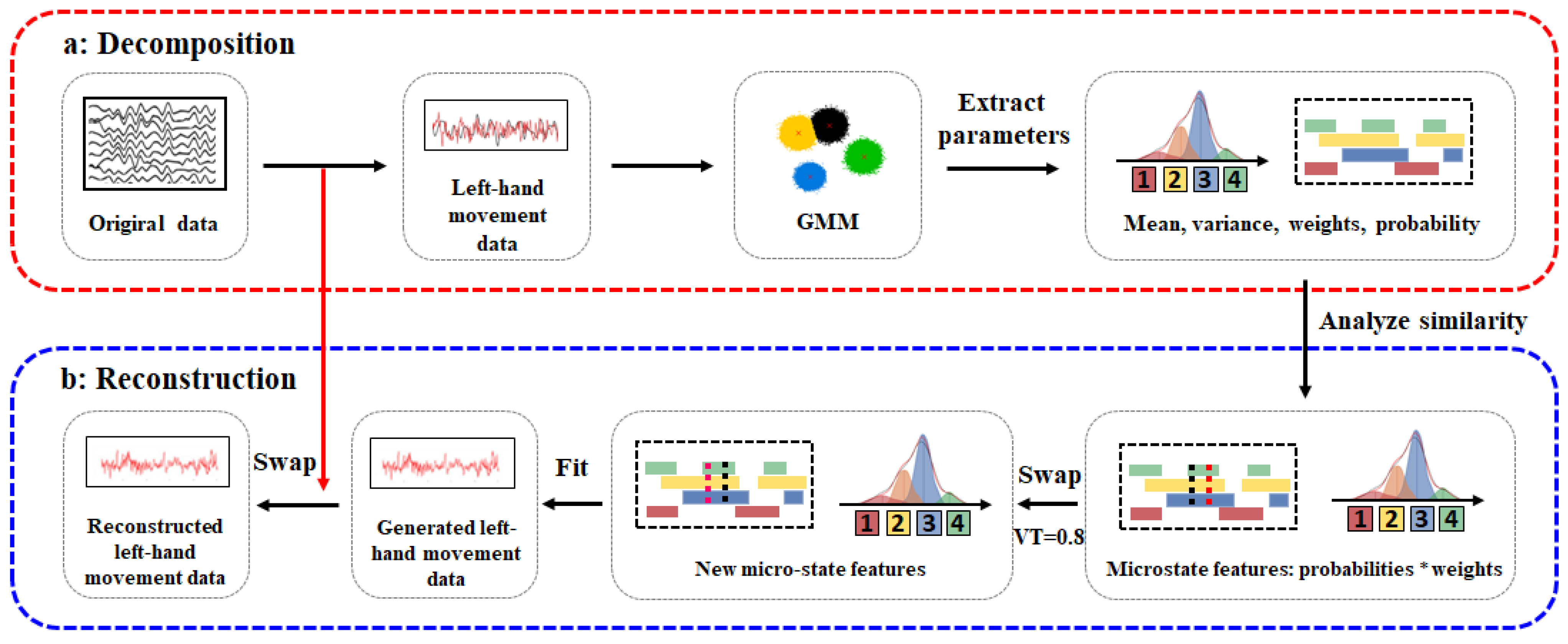
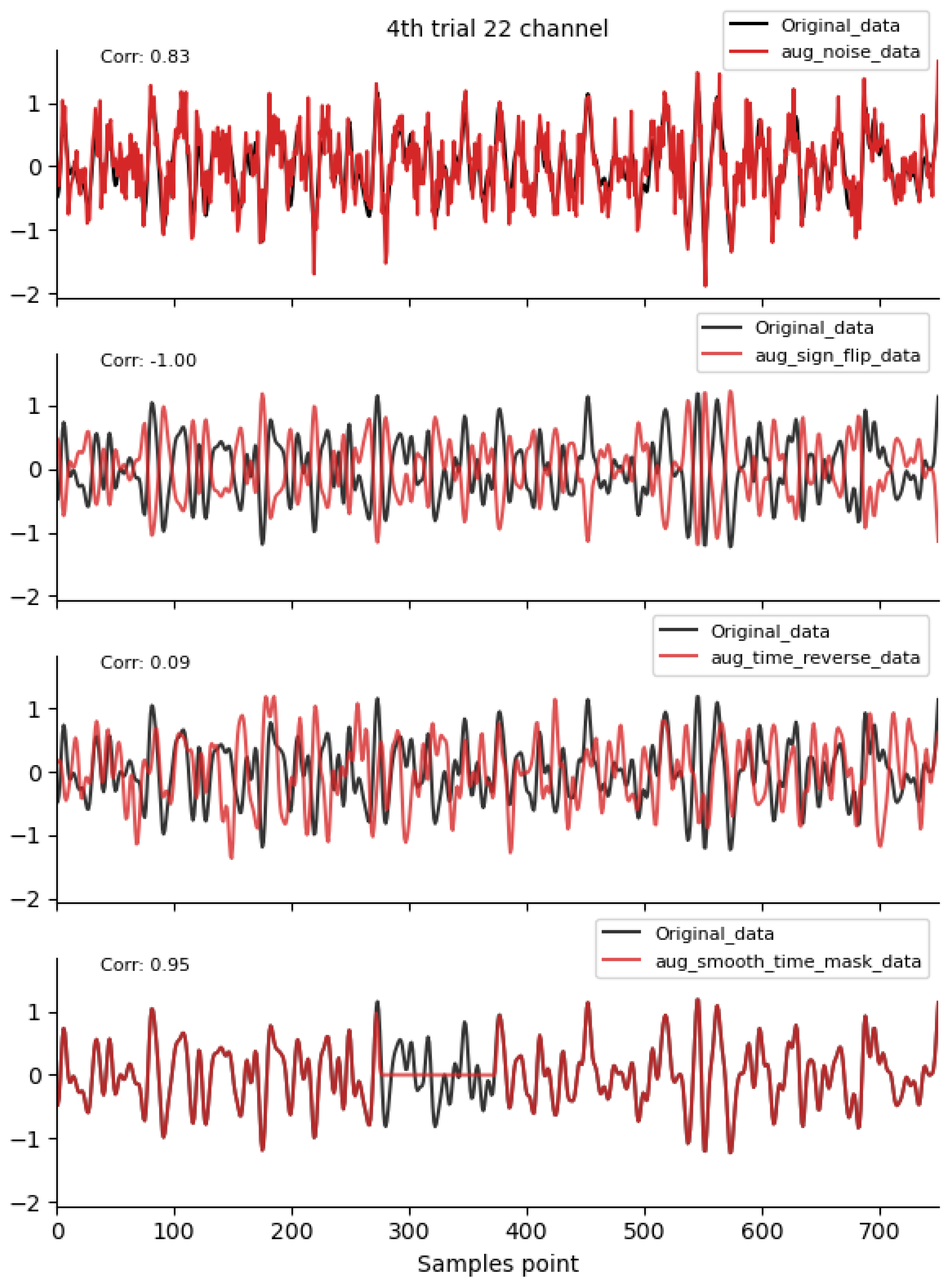

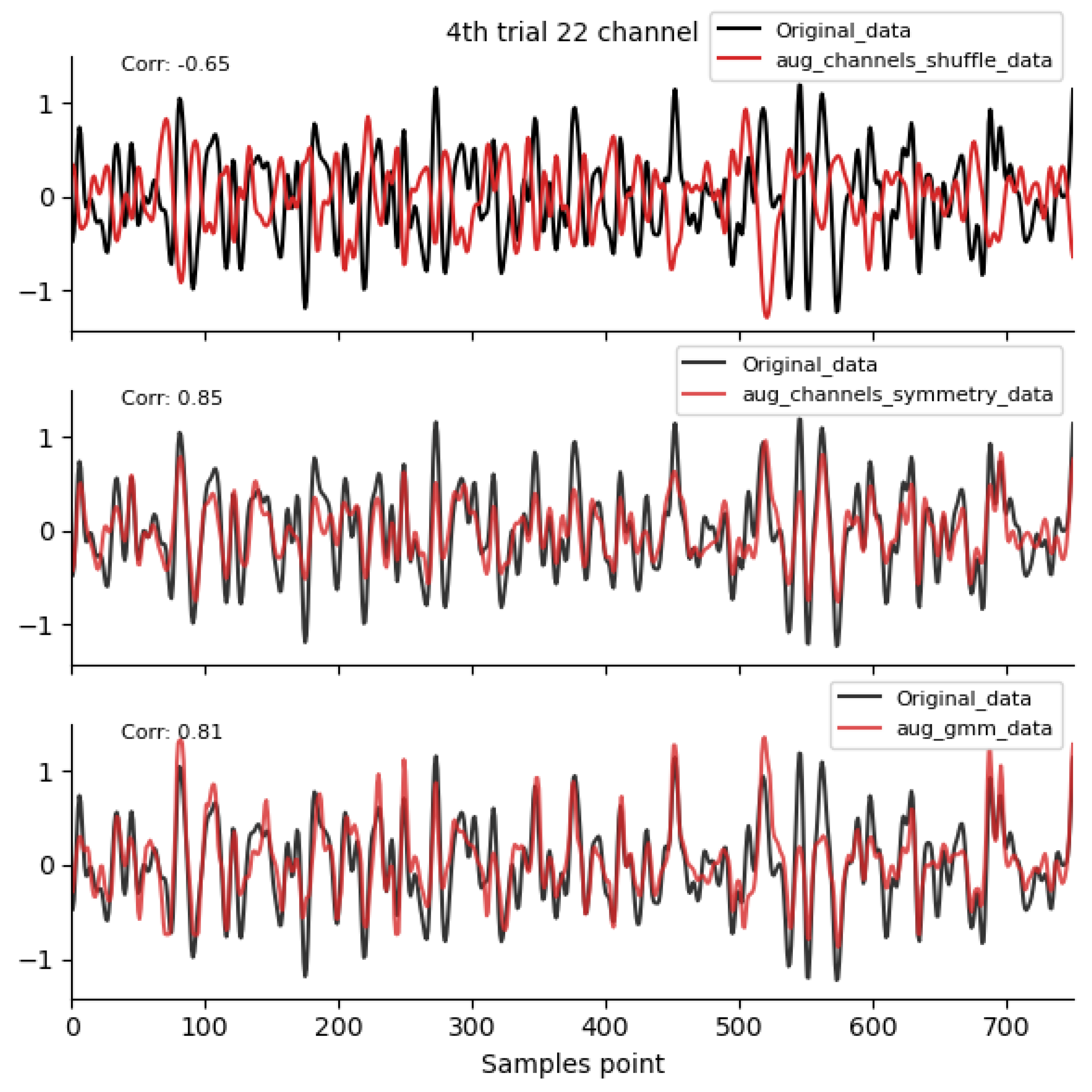
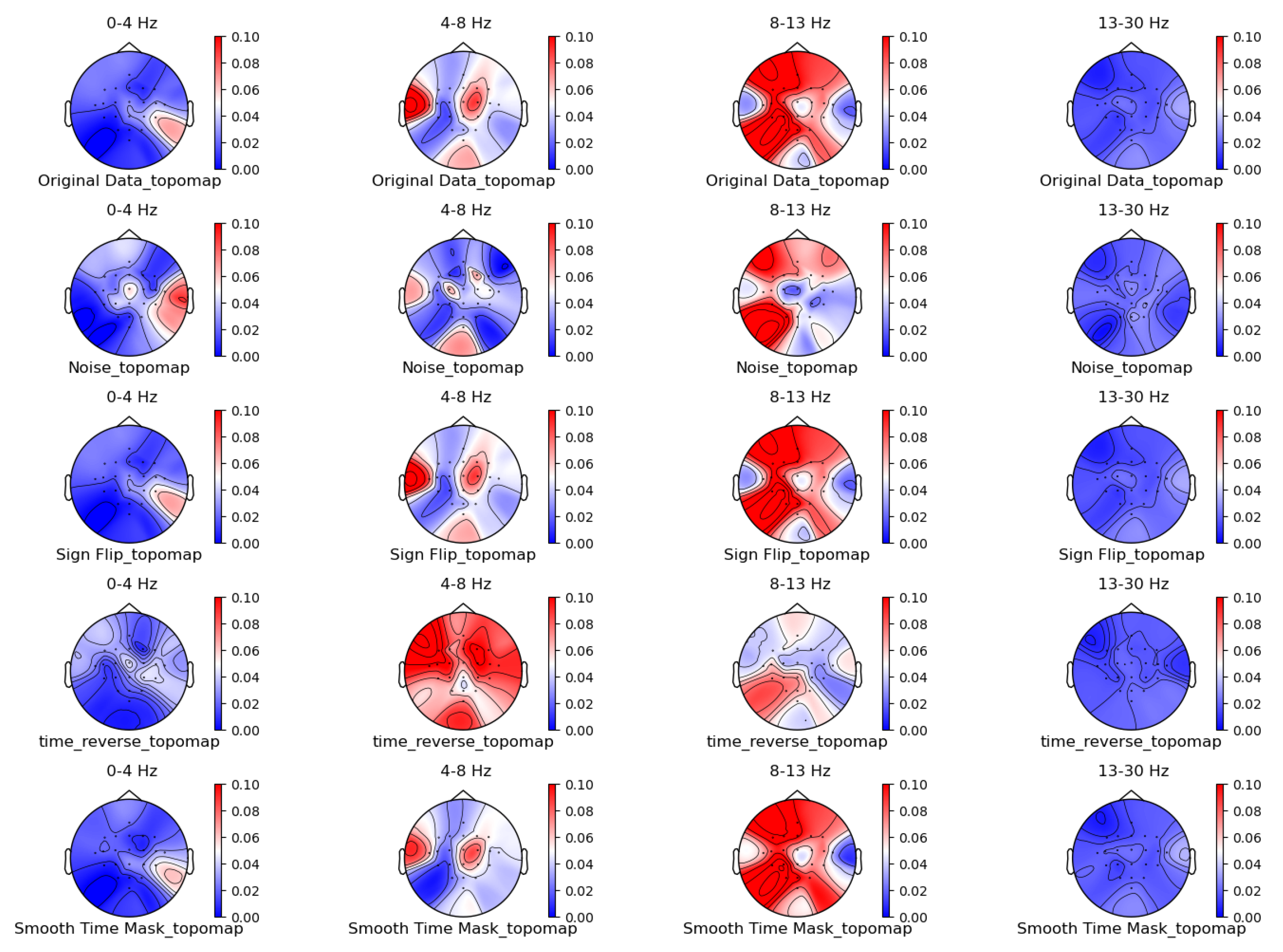
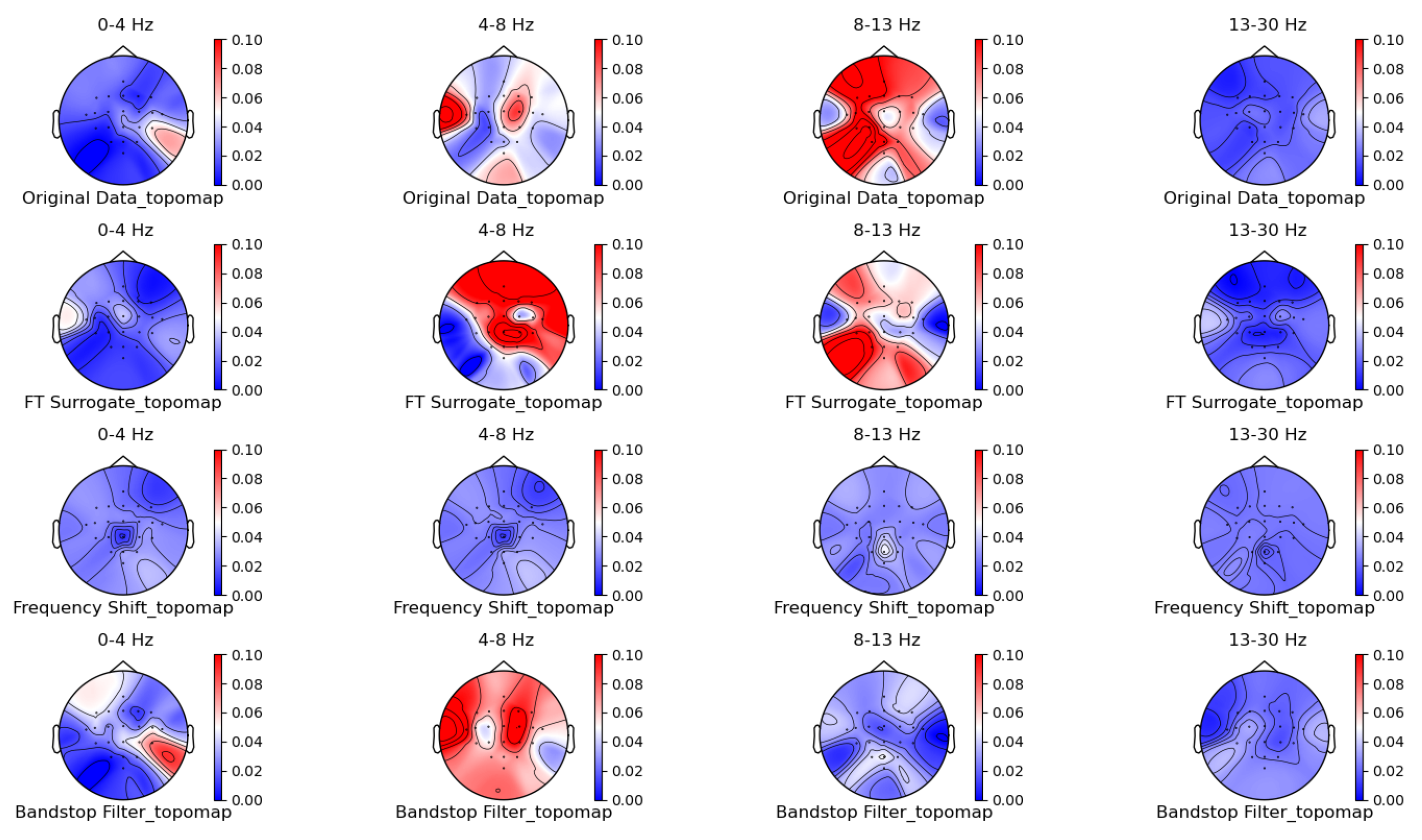


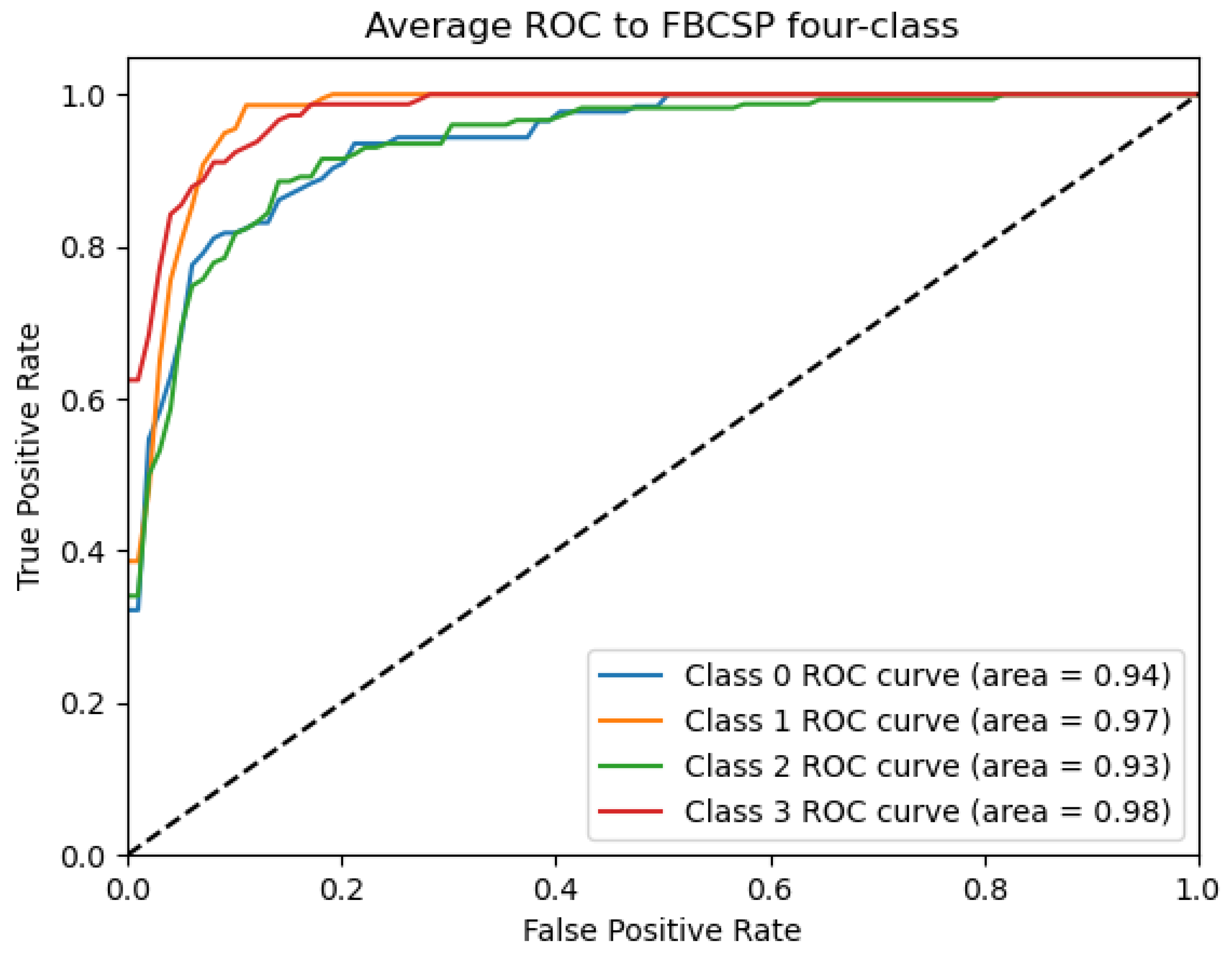
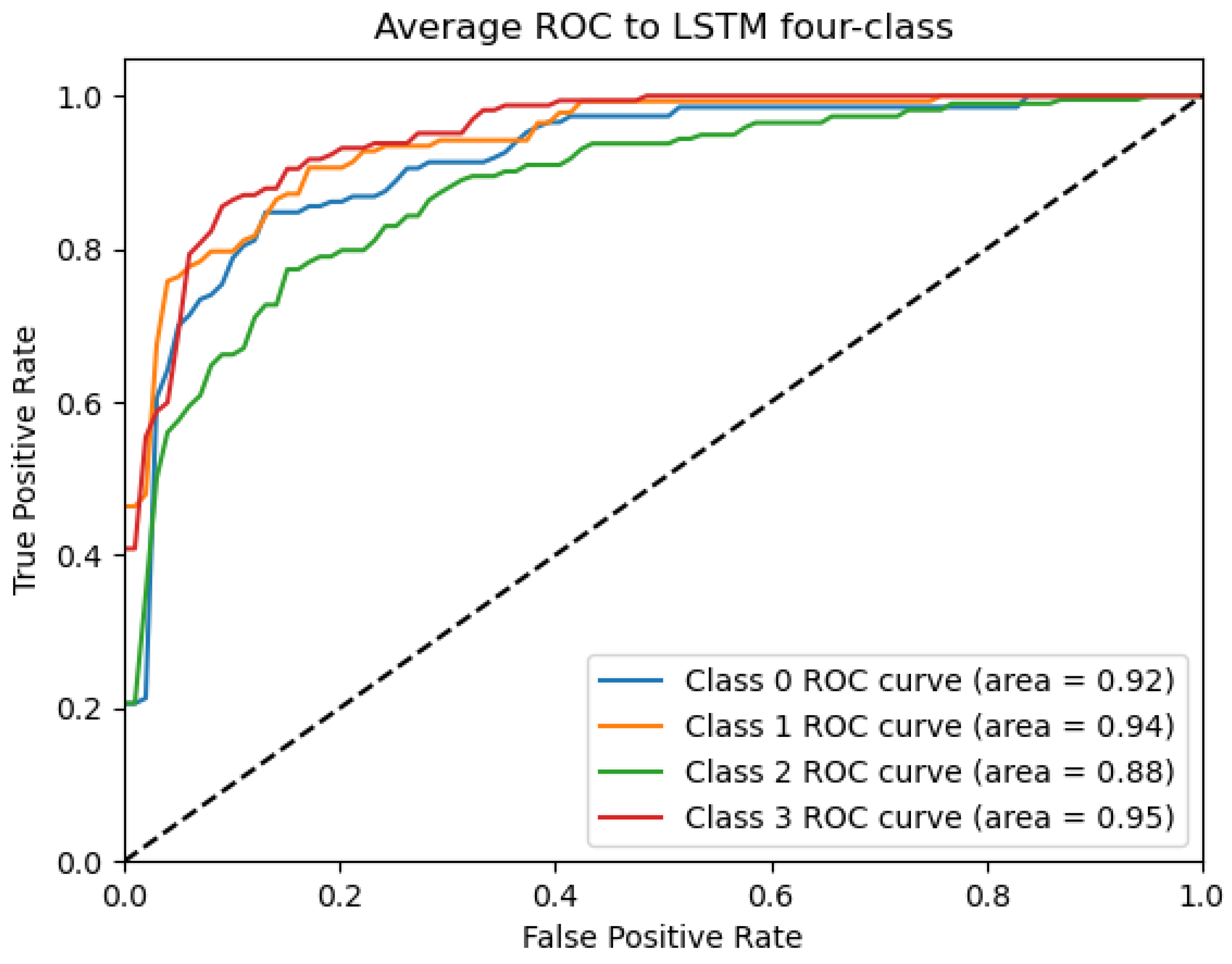



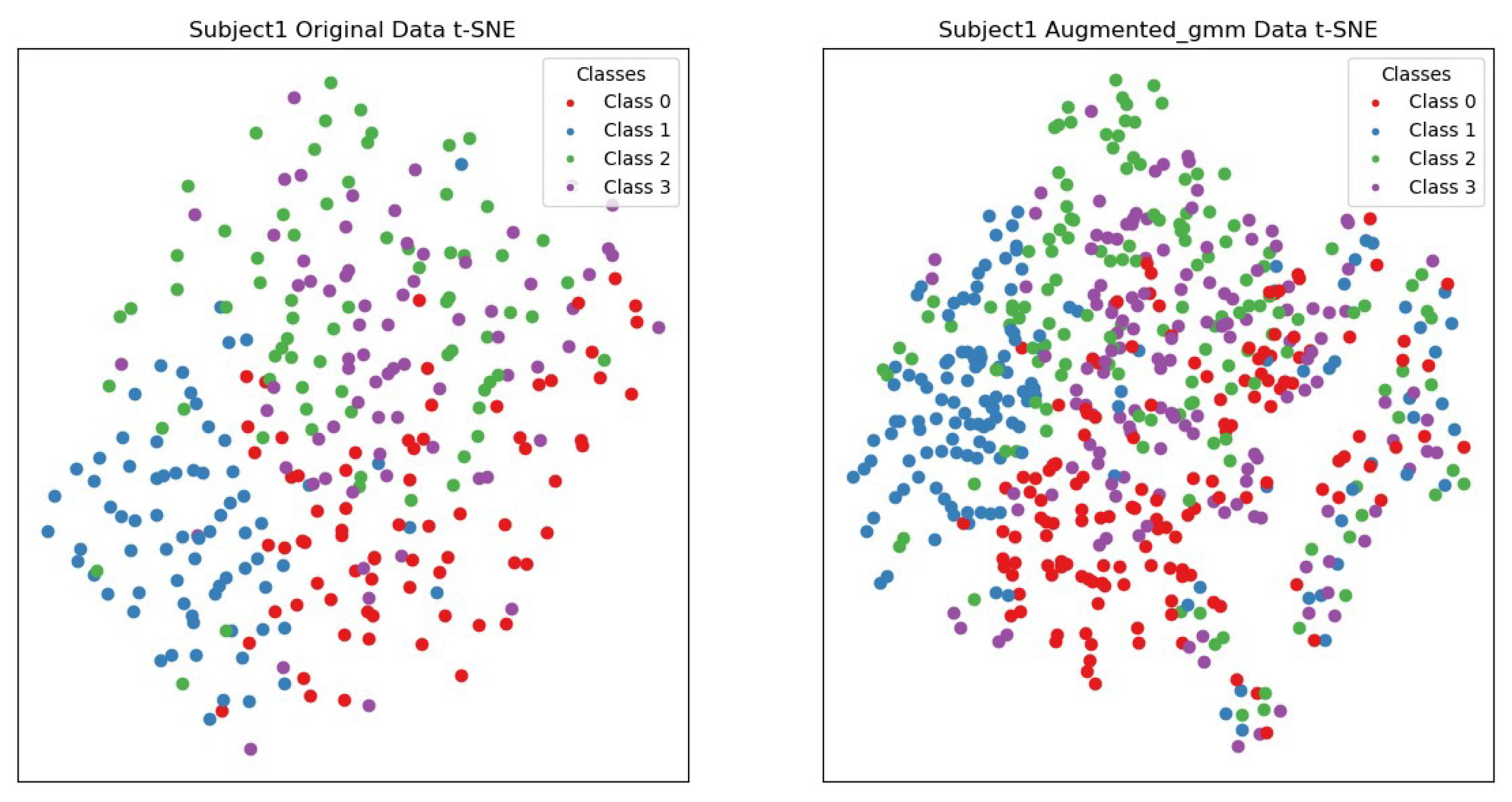
| Method | FBCSP [37] | LSTM [38] | EEGNet [39] | ShallNet [40] | Deep4Net [41] | Avg | SD |
|---|---|---|---|---|---|---|---|
| Original data | 67.75 | 48.17 | 46.07 | 48.91 | 52.89 | 52.76 | 8.74 |
| Noise Addition | 73.22 | 80.72 | 75.29 | 80.32 | 83.08 | 78.53 | 4.10 |
| Sign Flip | 74.63 | 80.72 | 74.50 | 81.84 | 82.75 | 78.89 | 4.01 |
| Time Reverse | 78.27 | 79.32 | 76.39 | 79.73 | 79.90 | 78.72 | 1.45 |
| Time Masking | 75.46 | 79.88 | 75.52 | 80.17 | 80.92 | 78.39 | 2.67 |
| FT Surrogate | 81.26 | 77.60 | 73.34 | 80.13 | 82.19 | 78.90 | 3.55 |
| Frequency Shift | 81.18 | 74.40 | 68.47 | 72.79 | 76.83 | 74.73 | 4.72 |
| Bandstop Filter | 76.32 | 78.39 | 76.98 | 78.16 | 81.13 | 78.20 | 1.85 |
| Channel Sym | 77.87 | 75.86 | 73.93 | 79.47 | 81.61 | 77.75 | 3.00 |
| Channel Shuffle | 78.59 | 76.51 | 68.29 | 75.06 | 79.86 | 75.66 | 4.52 |
| GMM Aug | 79.67 | 80.53 | 77.70 | 82.61 | 82.73 | 80.64 | 2.11 |
Disclaimer/Publisher’s Note: The statements, opinions and data contained in all publications are solely those of the individual author(s) and contributor(s) and not of MDPI and/or the editor(s). MDPI and/or the editor(s) disclaim responsibility for any injury to people or property resulting from any ideas, methods, instructions or products referred to in the content. |
© 2025 by the authors. Licensee MDPI, Basel, Switzerland. This article is an open access article distributed under the terms and conditions of the Creative Commons Attribution (CC BY) license (https://creativecommons.org/licenses/by/4.0/).
Share and Cite
Liao, C.; Zhao, S.; Wang, X.; Zhang, J.; Liao, Y.; Wu, X. EEG Data Augmentation Method Based on the Gaussian Mixture Model. Mathematics 2025, 13, 729. https://doi.org/10.3390/math13050729
Liao C, Zhao S, Wang X, Zhang J, Liao Y, Wu X. EEG Data Augmentation Method Based on the Gaussian Mixture Model. Mathematics. 2025; 13(5):729. https://doi.org/10.3390/math13050729
Chicago/Turabian StyleLiao, Chuncheng, Shiyu Zhao, Xiangcun Wang, Jiacai Zhang, Yongzhong Liao, and Xia Wu. 2025. "EEG Data Augmentation Method Based on the Gaussian Mixture Model" Mathematics 13, no. 5: 729. https://doi.org/10.3390/math13050729
APA StyleLiao, C., Zhao, S., Wang, X., Zhang, J., Liao, Y., & Wu, X. (2025). EEG Data Augmentation Method Based on the Gaussian Mixture Model. Mathematics, 13(5), 729. https://doi.org/10.3390/math13050729






